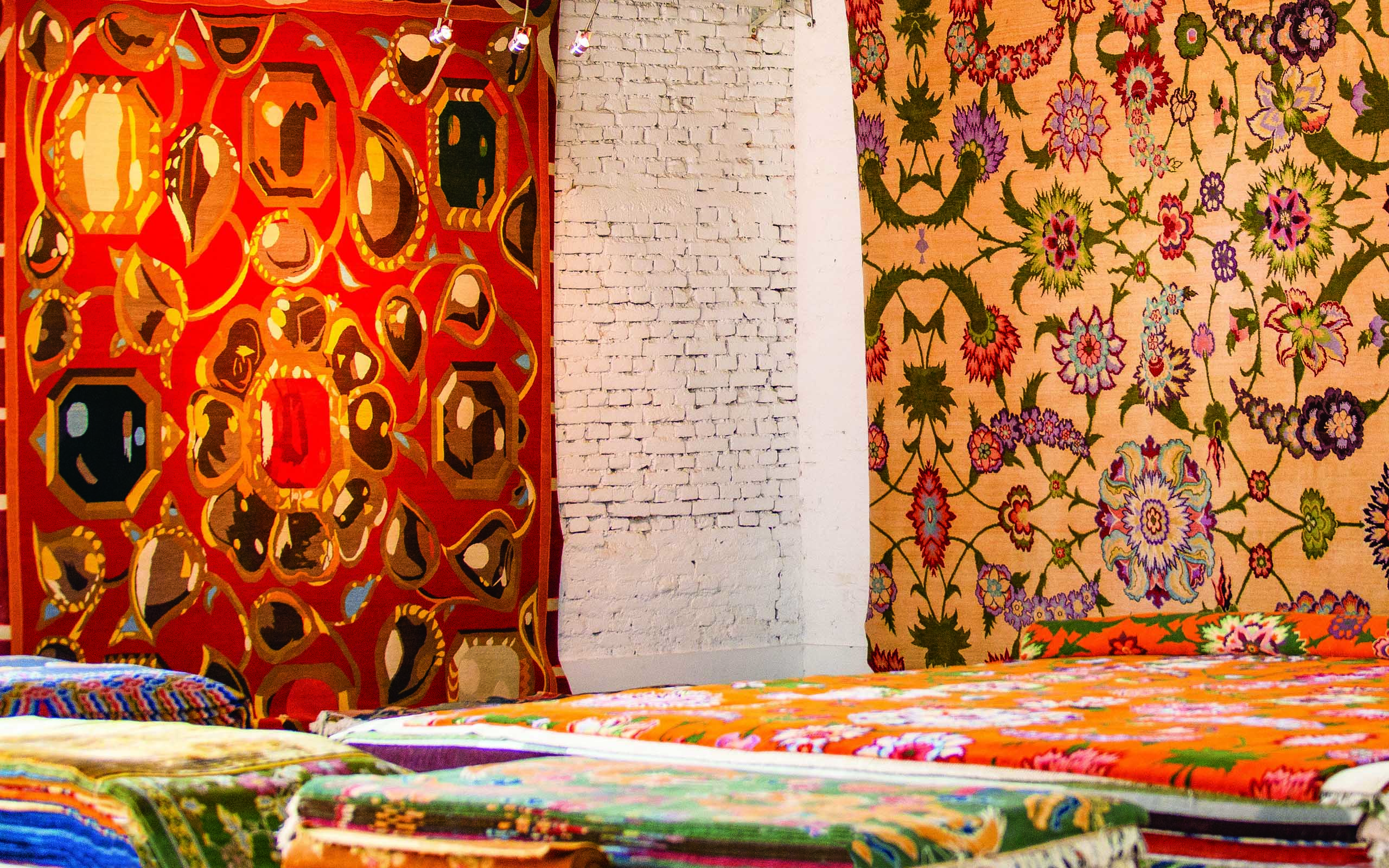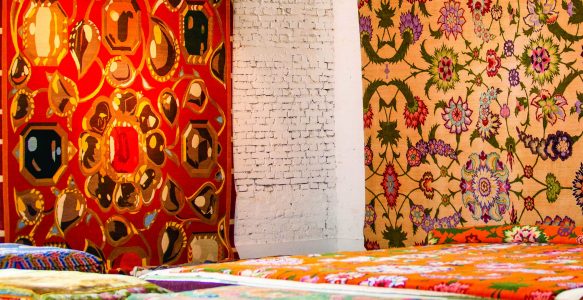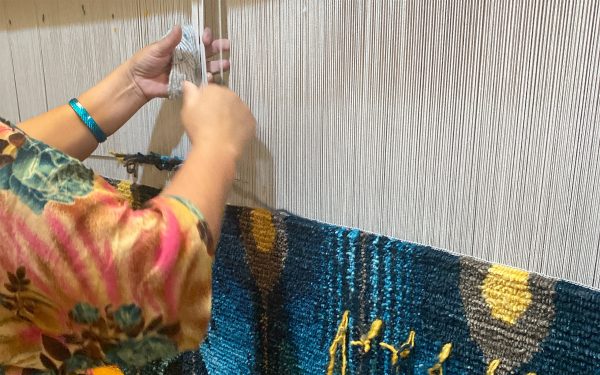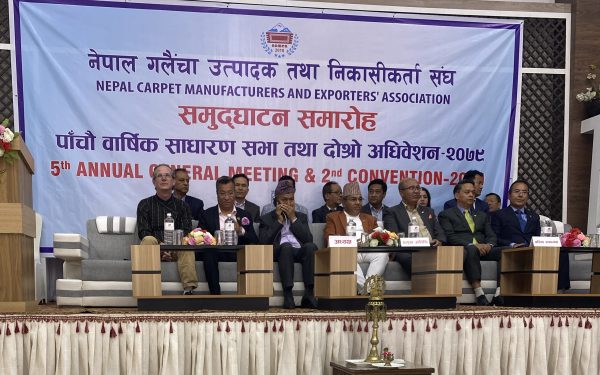These prepared remarks were originally presented to attendees of DOMOTEX during the annual rug and carpet trade fair hosted in Hannover, Germany on Friday, 13 January 2023.
Introduction
Good morning Ladies and Gentlemen, my name is Michael Christie, though perhaps you know be better by my nom de plume, The Ruggist. It is under this moniker that for the past 14 years I have been promoting better and best quality handknotted rugs and carpets; most often those coming specifically from Nepal. This affinity for quality was fostered early in my career, which began for this former outsider in 1996 as a showroom technician, vacuuming, receiving, delivering, and the like. I did all the so-called menial tasks necessary to run a showroom, so important we might be inclined to call them essential, but more on this later.
It was during these formative years in the 1990s that I was exposed to rugs and carpets which piqued my aesthetic interest and throughout the subsequent decades I have endeavoured to associate myself with brands espousing luxury, quality, and craftsmanship. Learning and re-learning along the way how those concepts are subjective and relative and likewise prone to change – as they must – in order to suit needs and wants of ever shifting contemporary society.
Time progressed as it does and my evolving career – such that it is – exposed me to myriad factors which have and continue to influence my thoughts. First as showroom technician – porter if you will, then as salesman, as showroom manager, as wholesale representative, as would be carpet wholesaler, as maker, as blogger, writer/commentator, and as Editor I have worked across a spectrum of positions; the collective sum of which contributes to a brands perception, at least in the eyes of the consuming public. I’ve also come to realize that much of that work was and remains premised on imperfect information, a biased distortion of truth and reality, and an inclination toward what we might call in this era ‘positive vibes only.’ I was, for the sake of simplicity, a rug salesperson.
This is not to say that what we think we know about rugs and carpets is wrong, but it is to say it is presented in a manner which – like most of contemporary society – treats inconveniences, particularly those contrary to the narrative of established norms and traditions, with a degree of cognitive dissonance. In short, our actions are not always aligned with the entirety of the situation.
For whatever reason, none of this was apparent to me prior to the pandemic. And while I am loath to laud the last several years as beneficial, the opportunities presented during the pandemic – for those of us who choose not to be a victim of circumstance – offered rare chance to reassess, rethink, and reset our deeds and actions both individually and collectively.
In 2020 I asked myself on more than one occasion: ‘Am I essential?’ ‘What does ‘being essential’ even mean?’ And while I still ponder those from an existentialist philosophical viewpoint, I have come to understand the importance of thinking about the essentials when it comes to rugs and carpets. And not just my beloved high-quality handknotted rugs and carpets made of exotic natural materials. No! This is about all manner of rugs and carpets from inexpensive self-launderable rugs, to the visually striking machine-made rugs now available, to anything one might be able to find at any rug showroom or online marketplace the world over, or for that matter here in the halls of DOMOTEX. So in asking myself. ‘What is essential for the future success of the rug and carpet industry?’ I have only one answer: ‘Luxury Carpets Must be Sustainable.’
On Luxury
To be luxurious is to have that which one does not need, rather what one wants. To be sustainable is to act in a manner in harmony with the needs of the environment and humanity. Humans – myself included – want to be luxurious, yet civilization itself needs to be sustainable; this is true regardless of individual socio-economic status which I mention only to remind that all of this discussion takes place in an economic reality which favours ever increasing profits at the expense of all else. It is such that we tend to emphasis price – as denominated in the currency of your choosing – rather than cost – denominated as it is in what we choose to exploit.
Detractors to change are often keen to point out the success of humanity thus far as proof of our continued success, and in many ways it is indeed often best to leave well enough alone. But to look around the world today with eyes open wide is to reveal, as I might say in polite terms, many unsuccesses. As we enter what is likely to be called the ‘Anthropocene’ I posit the maxim ‘past performance does not guarantee future success’ is worthy of note.
I have written many times about the difference between needs and wants, perhaps better expressed in this context as essentials (or necessities) versus luxuries (or wants). This distinction betwixt what is essential for life – an ever shifting standard I might add – and what makes life comfortable – again an ever shifting standard – lies at the heart of my argument for the sustainable carpet. With fleetingly rare exception are carpets made by and for those who require them, that is need them, in their daily life. After all, who amongst us lives in a tent in the dessert?
Thus it is that a ‘luxury carpet’ is not just the rarified carpet favoured by pretentious carpet snobs of privilege like myself, rather a ‘luxury carpet’ is any rug or carpet sold not as necessity or need, but rather as something we simply want to have. And I don’t mean ostentatious and affected needs we might profess in inflated language used to sell Interior Design, such as ‘Your lake house could really use a carpet in the great room to complete the space,’ or as in every rug dealer’s favourite film, ‘The Big Lebowski,’ ‘Yeah man. It really tied the room together.’ I mean genuine, actual need, as in, if you’ll pardon the hyperbole of this analogy, ‘I need water,’ ‘I need food,’ I need shelter.’
On Sustainability
In contrast to our ephemeral and indeed fanciful whims of want based consumption are the needs of our planet; there simply are no wants. The environment, life, all of this that we think is so important, is predicated on the ability of the natural world in which live to continue to sustain us. And while it is I make no predictions as to when or if that ability will cease, the science is now clear that humans are causing great, perhaps irreparable, harm to this planet. For the sake of future generations… . No, perhaps that is too abstract of a concept. For the sake of the individual grand-children of each of you listening to my words today, collectively we must make change.
But sustainability is not solely about the environment though admittedly it plays an extremely outsized role and is, if you remember only one thing from this presentation, it is the one you must act upon. Sustainability is also, in a somewhat sophomoric manner, the ability to sustain. To sustain people, to sustain work, to sustain livelihoods, businesses, so on and so forth. In other words, if the system does not allow for continued functioning without the erroneous and false notion of unlimited grown within a finite system, then it is not sustainable.
At first these concepts of luxury and sustainability may seem contradictory for it is that the modern trade of all types of rugs and carpets is one which meets the comfortable wants of consumers, not their essential needs. Moreover, with exceptions of course, this trade does not in any meaningful, constructive, or transformative way, address the needs of the planet. Yet the unfamiliar path forward, now an imperative course of action, is clear. From the obvious such as materials selection, construction, and circular regeneration, to well intentioned design, the manner in which we trade and promote rugs and carpets, and the often neglected equitability of the entire supply chain, no portion of the trade must be overlooked as we craft the sustainable luxury carpets of the this the early 21st century.
The Path Forward
None of this is said as an indictment against luxury, nor the rug and carpet trade itself. Commerce and trade have proven time and again to be a beneficial force which has allowed civilization to be, well, civilization. Without trade, without commerce, without specialized careers, so on and so forth, all of what we know and perhaps love would not exist.
This is said however as a provocative statement of reality and truth told from a perspective other than that of the rug salesman I once was, though in many ways still am.
It is said a tiger cannot change his stripes, but what we can do, what this particular beast – if you will – has done, is learn empathy, to come to try and understand the world through different eyes, disparate life experiences, and via perspectives as varied in number as there are humans on earth.
When I listed the roles and positions I have held over the course of my career, you’ll note they are concentrated in the commerce and trade of rugs and carpets, not their manufacture nor making. So in the past when I have spoken about rugs and carpets, I did so with bias, with haughty airs and a pretence not uncommon for those who have long ago moved away from menial manual labour or perhaps never done it at all. Forgotten and overlooked, as it often is, was the perspective of those who choose to weave or, perhaps more realistically, those who though systemic conditions beyond their control, have no other viable employment option but to weave.
For the wealthy consumer the carpet is indeed a luxurious indulgence of want, for weavers – and indeed other technicians involved in the craft of carpetry – the carpet is merely the result of their labours, a means to provide for their very basic humans needs, particularly in this era of commercialization, consumerism, and rapidly increasing inequality. This was made apparent during the early days of the pandemic when arguably necessary lockdowns interrupted production, and thus pay, for the most vulnerable in the supply chain. Reflecting back for a moment, I question why we perpetuate a system which dictates those living in luxury do so at the expense of those struggling merely to survive. Moreover in the case of lockdown disruptions, why those who weave should be required to risk their very health so that a wealthy luxury consumer could enjoy a rug in their home that noöne should have then been visiting.
What We Need
It is my position that the one true requirement of the rug and carpet trade, is not that of satisfying the consumer at any and all cost, rather it is crafting and trading rugs and carpets that are actually sustainable. For in doing so we act in our own collective best interests both in terms of preserving the environment, but also in preserving and adapting this trade to the needs of the environment and more importantly to said trade, fulfilling the wants of future generations of consumers.
Examining it All
Just as I have included all manner of rugs and carpets in my definition of a luxury carpet so too must we include every aspect of the entire supply and distribution chain when we define what is or is not sustainable. Contrary to my past stated position that the reality of the rug world is not binary, not yes/no, nor black/white, rather shades of grey, I will make exception for sustainability. It is simply either sustainable or it is not.
I take this position based upon my observations of how corporations and the like tend to jump upon whatever is, dare I say, trending in society. Being green was once so hot it begat the term greenwashing to describe capitalistic marketing and advertising efforts to exaggerate the environmental bona fides of a particular firm or product. And it is today that sustainability is in danger of suffering the same fate.
In November of 2020 I read an advertisement of a well known international fast food restaurant chain which purported: ‘Canadian Beef, Now Sustainably Sourced*’ with an asterisk at the end of the word ‘sourced’ denoting a footnote. This footnote read: ‘Up to 30%’ of the beef in one particular sandwich of this chain’s numerous offerings was sustainably sourced. Thirty percent, of one product of many. Yes the information was presented, but the manner of its presentation was intended to deceive the consumer by allowing them to infer the entirety of the restaurant’s beef is sourced sustainably. It isn’t, and this is but one example of greenwashing 2.0.
So what we must do, perhaps the second thing to remember from this presentation, is we must speak truthfully in order to avoid greenwashing the problem; said another way we must not deceive. This is not to say we cannot polish the truth to present information in more palatable forms, because we can and many times we should, but we mustn’t allow the borrowed credibility of small almost inconsequential actions to inflate the credentials and merits of the rugs and carpets we are making. To relate this to something less abstract, paper straws alone will not save the planet.
Actions Not Words
Real solutions however require real actions and not just words. This is a dilemma for someone like me who has spent a significant amount of time over the past decade writing words in the hope they influence someone to affect change. How much, as someone on the payroll of the industry – in one way or the other – how much can I genuinely speak truth to power? How much of the so-called mystique of the rug and carpet trade can be revealed in order to foster the change this industry so requires to remain relevant and competitive? How many faults can be pointed out as if I am asking a mysterious someone from the ether to offer up solution? We are that someone and we have to take action.
There is a song from 1968, ‘Revolution,’ by The Beatles, perhaps you know it. To paraphrase, ‘You say you want a revolution, we’d all love to see the plan.’
Thus it is then that I come here today, not with a fully realized plan per se, but with a call to action. It is now up to all of us to not only formulate said plan but follow through with meaningful action in order to bring it to fruition.
It begins, as it must, with a thorough assessment of the sustainability status of the full variety of rugs and carpets we are making. From the origins of the materials we are using through to the manner in which the final product is delivered to the end consumer and then yes, even how the carpet will be retired at its end of use, we must evaluate everything. If I were to guess, and I am, few rugs today would truly meet the high standard of sustainability I thus imagine. Great! We now know what needs to be improved and where to start.
To provide but one example, I return this discourse to my area of high expertise, handknotted rugs and carpets. Typically made of natural materials it is easy to assume these products are sustainable, but therein lies an error: assumption. In these determinations we cannot assume, we must verify and furthermore we must not allow our proximity to an earlier historical or traditional era to render us susceptible to transient or deeply held passions – of which I certainly have many. We must instead use expert knowledge to guide us with superior insight.
Is the wool used in the making of a hanknotted rug sustainably processed? What is its impact on water supplies? Is the shepherd being paid fairly? Is shipping wool from one country to another an acceptable use of resources and is it necessary? Is there a domestic wool of the country of production which might be suitable?
And how is that wool dyed? Are the dyestuffs toxic? Inert? Are we mitigating the risks? Does the dye master have appropriate safety equipment? Are we treating the effluent to proper environmental standards, not just those legally acceptable in some out of sight out of mind foreign land?
Are those crafting the rug or carpet treated fairly and equitably? Do they have access to resources to meet their needs or are they beholden to a system which seeks to exploit them?
What of the finished rug? What becomes of it when it reaches its end of life or end of use? Can it be taken apart to be recycled or composted? Does it become landfill? Did its design and manufacture incorporate principles of circular design?
Conclusion
Speaking broadly to all rugs and carpets, we must think and ask generationally. Yes! It is great that this new rug is made of recycled plastic bottles but was the rug itself designed to be recycled? Moreover, can it actually be recycled? Do the facilities exist to allow for it to be recycled? If not, then we aren’t solving the problem, we are merely delaying into the future, burdening all of our grand-children with problems we didn’t think were important enough to solve.
The recently enacted Consumer Sustainability Reporting Directive (CSRD) here in the European Union is to be a game changer in terms of sustainability requirements. While these rules apply to large scale enterprises and – as I read it – many rugs companies are likely too small in scale to be subject to the rules, this does not absolve us of the moral and ethical responsibilities required for true sustainability.
And these responsibilities are many. Due to time constraints I’ve not even began to touch on tangentially related problems affecting sustainability such as over-consumption and products whose durability and time in use are incongruous.
Given the storied origins of the rug and carpet trade, from the time itinerant traders first came into contact with tribal weavers, through the first industrial revolution, up to today and the bounty of options now before us, I can think of no better legacy to leave our progeny then that of a moment in time when a conscientious decision was made to stop exploiting and start sustaining.
In conclusion, we only need acknowledge that for a system to work it must work for everyone and everything that is part of the system. This is what I call equitable sustainability and it requires a wholistic approach to decision making in order to craft the sustainable luxury carpets I predict future consumer demographics will want.
Before I open the floor to questions, I thank DOMOTEX for inviting me here to speak today, and I thank all of you for your time. Questions?





